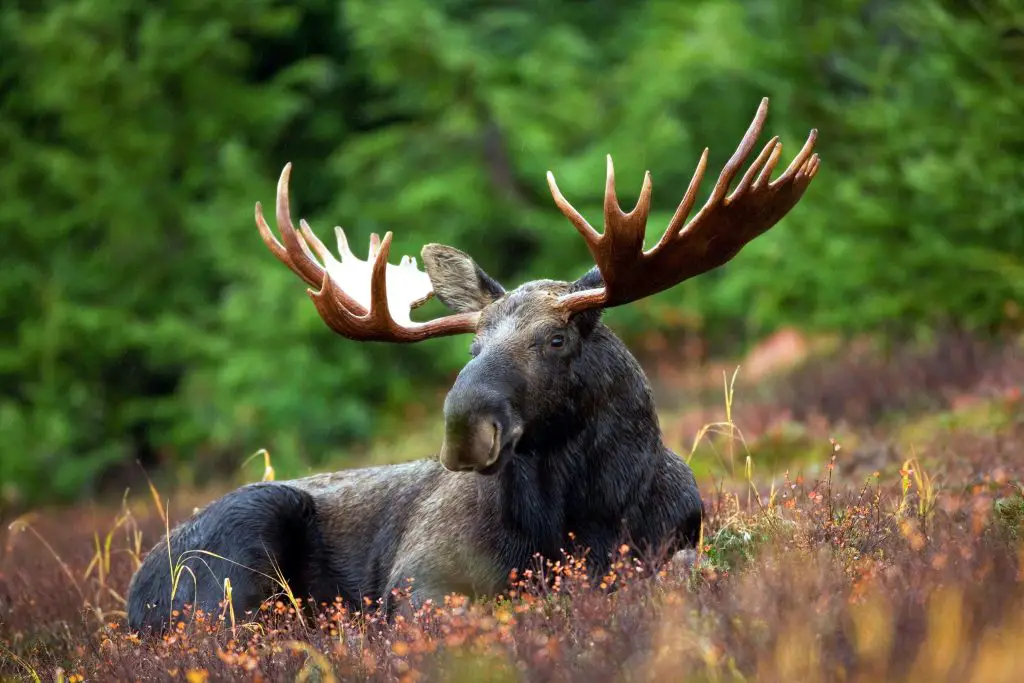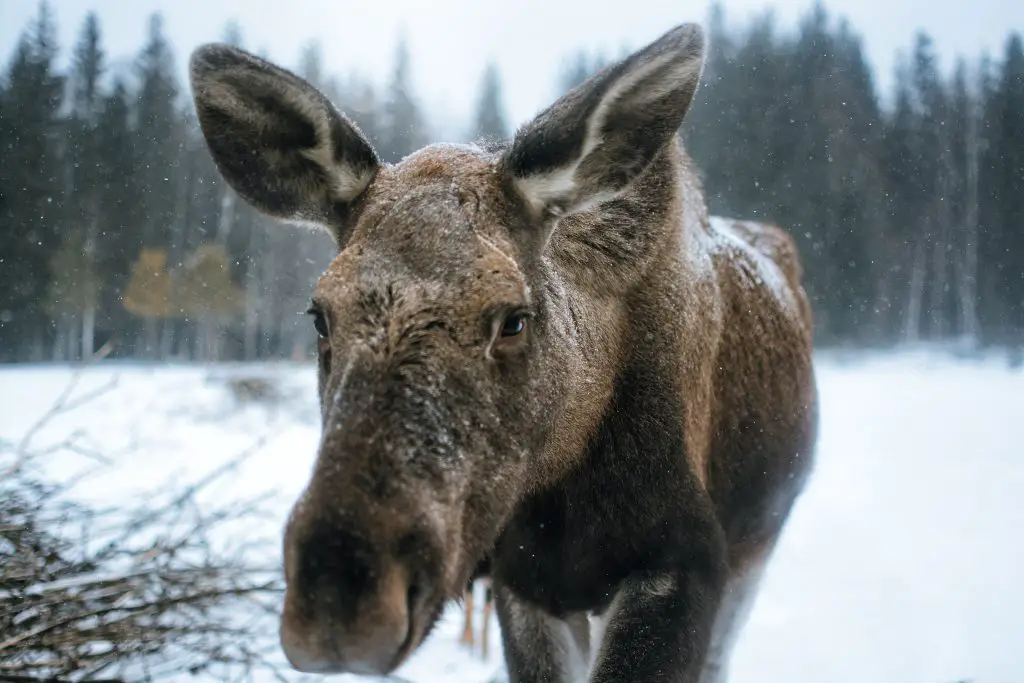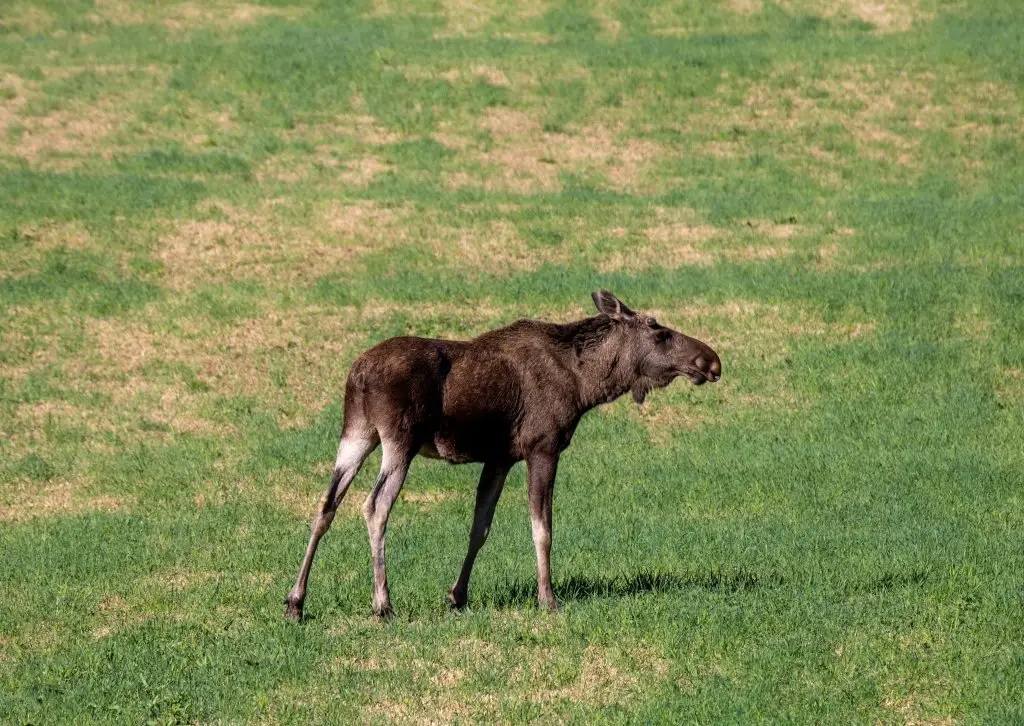How Fast Do Moose Run?
So how fast do Moose run really? Alaskan moose can reach speeds of 35 miles per hour over short distances. However, they usually only sustain this speed for about 300 yards before needing a rest. They can maintain a more casual trot for long periods at an average speed of 20 miles per hour.
Shiras moose are similar in size but tend to be slower runners overall, with top speeds around 30 miles per hour. Eurasian moose aren’t quite as large as their Alaskan counterparts but are still fairly sizable animals.
So, now you know how fast moose can run. But how do they compare to others in the animal kingdom?
The cheetah is the fastest land animal and can reach speeds of up to 70 miles per hour. That’s almost twice as fast as the Alaskan moose! The pronghorn antelope is the second fastest land animal and can reach speeds of up to 60 miles per hour. That’s still 10 miles per hour faster than the Alaskan moose. So, although these large animals are quite capable of moving quickly, they’re not at the top of the list for land animals.
Where Did the Word Moose Come From?
The word “moose” is derived from the Algonquian word for the animal, which means “eater of twigs”.
What is a male Moose Called?
A male moose is called a bull the same as many other male animals. They can have huge antlers, which can be truly awe-inspiring.

What is a female Moose Called?
A female moose is called a cow, again similarly to others in the animal world.

What is a baby Moose called?
A baby moose, not surprisingly based on the nomenclature for adults, is called a calf.

Where Do Moose Live?
Moose are generally solitary animals and live in North America, Europe, and Asia. They are the largest member of the deer family and can weigh up to 1,800 pounds or even more, making them one of the largest animals outside of Africa.
Moose Subspecies in North America
As you probably know, there are four main subspecies of moose in North America. The Eastern moose, western moose, Shiras moose, and Alaskan moose. They are the tallest mammal in North America.
- The Eastern moose can be found in Eastern Canada and Northeastern United States.
- The Western moose ranges over British Columbia to western Ontario, Northern Wisconsin, Minnesota and North Dakota and the Upper Peninsula in Michigan.
- The Shiras moose is the smallest of the four subspecies and it’s range covers Wyoming, Utah, Colorado, Oregon, Washington, Idaho and Montana.
- The Alaskan moose is the largest moose of all the subspecies and can weigh up to 2,000 pounds! They are found in Alaska and the Western Yukon. Alaskan moose are the most aggressive when threatened.
The Four Species of Moose across the World
There are also four subspecies of Moose outside of North America. In other parts of the world they are often referred to as elk rather than Moose, which are obviously a different animal from North American Elk.
- The European Elk can today be found in Russia, Estonia, Latvia, Finland, Sweden, Norway as well as parts of Poland, Lithuania and Belarus and small populations in the Czech Republic, Slovakia and northern Ukraine.
- The Yakutia, Mid-Siberian or Lena Elk ranges over eastern Siberia, Mongolia and Manchuria, but is predominantly found in the forests of eastern Russia. This is the most common Moose in Asia.
- The Ussuri, Amur or Manchurian Elk is found in far eastern Russia and the northeastern part of China. This subspecies has much smaller antlers, or they lack antlers entirely. This is the smallest Moose subspecies in the world, standing between 5.5 and 6 feet high at the shoulder and weighing on average 440 to 775 pounds.
- The Chukotka or East Siberian Elk can be found in northeastern Siberia and the Kamchatka Peninsula – this is the largest and tallest Moose subspecies in Eurasia – Bulls can grow to over 7 feet tall and weigh upwards of 1,500 pounds.
Moose ‘Running on Water’ is a Miraculous Sight
As we’ve discussed, Moose can reach speeds of up to 35 miles per hour. That is impressive, but it’s truly awe-inspiring to see the raw power they have. Take a look at this video of a moose charging through the water. Wow!
In the wild, a moose will only need to run this fast when being chased by predators or during the rut (mating season). But as the video above shows, even in less extreme circumstances, a moose can reach some pretty impressive speeds with their long legs.
So the next time you see a moose, remember just how large, powerful and fast they really are.
How Dangerous Are Moose?
While it is true that moose are very large animals, and can therefore cause a lot of damage if they were to charge at someone they are generally pretty calm, peaceful animals. However, bull moose can be aggressive during mating or breeding season and cow moose are very protective of their calves. Be careful not to come between a cow and her calf or you may be in trouble! According to the National Forest Foundation, Moose actually injure more people than any other wild animal in the Americas, so take that under advisement.
Eight Signs a Moose May Chase or attack
If you’re planning on spending any time in moose country, it’s important to know the signs of a moose attack or chase. Here are eight of them:
- The moose is making loud noises
- The moose is stomping its feet
- The moose is pawing the ground
- The moose is shedding its antlers
- The moose is shaking its head
- The moose is raising its hackles
- The moose is making direct eye contact
- The moose is charging
If you see any of these signs, it’s important to back away slowly and give the moose a wide berth. And if a moose does chase or attack, remember that they can run up to 35 miles per hour, so don’t waste time trying to outrun them. Just focus on getting to safety in a vehicle or perhaps behind other cover such as a tree or boulder, etc.
What Is Moose Meat Called?
The term “moose meat” is simply the meat of the moose. It is a red meat, similar to that of beef, and is high in protein and low in fat. Moose are not typically farmed for their meat, but rather they are wild animals that are hunted similar to other deer species. The meat is lean and has a slightly sweet taste. It is a popular game meat in North America and is often used in stews, soups, and chili. Their massive bodies result in a ton of meat for a hunter who is lucky enough to harvest one.
Moose Size
Moose are the largest members of the deer family. They stand 5 to 6.5 feet tall at the shoulder and weigh between 800 and 1,200 pounds on average, but large Bulls can weigh much more than that.
Moose Habitat
Did you know that moose live only in areas that have seasonal snow cover? The animals prefer colder climates and cannot tolerate temperatures above 80 degrees Fahrenheit (27 degrees Celsius) for long. This is because they cannot sweat, and the fermentation caused by their digestion creates a large amount of heat. They have no problem navigating deep snow. They prefer to be around bodies of water and are excellent swimmers. In fact they can swim for miles at a time and can even submerge for up to 30 seconds as they feed on aquatic plants such as water lilies.
Offspring
After a gestation period of 231 days, females give birth to one calf. Like many wild animals, calves need to be up and moving quickly to survive, and Moose calves are up an moving within the first 24 hours. At birth, they weigh around 35.7 pounds (16.2 kg). Moose calves grow very quickly, gaining approximately 2.2 lbs. (1 kg) of body weight per day while they are nursing.
Calves wean after 6 months or so and are on their own at that point. At 4 to 6 years old they are fully grown, though many never make it to adulthood. Around 50 percent of calves fall victim to predators such as black bears, grizzly bears, or wolves in their first 6 weeks of life. Once they are adults, they have a survival rate of up to 95 percent and have lifespans of up to 20 years.
Classification
The taxonomy of moose, according to the Integrated Taxonomic Information System (ITIS), is:
- Kingdom: Animalia
- Subkingdom: Bilateria
- Infrakingdom: Deuterostomia
- Phylum: Chordata
- Subphylum: Vertebrata
- Infraphylum: Gnathostomata
- Superclass: Tetrapoda
- Class: Mammalia
- Subclass: Theria
- Infraclass: Eutheria
- Order: Artiodactyla
- Family: Cervidae
- Subfamily: Capreolinae
- Genus & species: Alces alces, Alces americanus (American moose)
- Subspecies: Alces alces alces (European elk), Alces alces caucasicus (Caucasian moose — extinct), Alces americanus americanus, Alces americanus cameloides
Conservation Status
Moose are categorized as “least concern” on the IUCN’s Red List of Threatened Species. That’s because they are very widespread and extremely abundant despite fairly intense hunting.
The global population of moose is estimated to be about 1.5 million and increasing. Even though they are large animals, young moose are prey for bears, wolves and cougars; about half do not live beyond 6 weeks. Adult moose, however, have a high chance for survival.
The biggest danger to moose is actually vehicle-moose collisions. Hundreds of moose are killed each year in Alaska, which has the highest rate of moose-vehicle collisions in the world.
So next time you’re driving in moose territory, be sure to keep your eyes peeled for these majestic creatures. And if you’re lucky enough to see one, just admire it from a safe distance – don’t try to get too close!
Conclusion
Overall, moose are fairly fast runners and can reach speeds of up to 35 miles per hour over short distances. However, they usually only sustain this speed for about 300 yards before needing a rest.
Shiras moose tend to be slower runners overall, with top speeds around 30 miles per hour. Eurasian moose aren’t quite as large as their Alaskan counterparts but are still sizable animals nonetheless. Hopefully through this article we’ve answered how fast do Moose run for you, as well as provided many other interesting facts about Moose across the world.

Leave a Reply